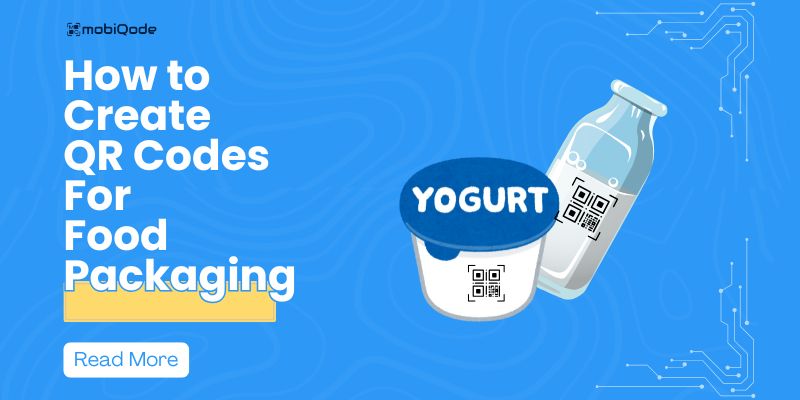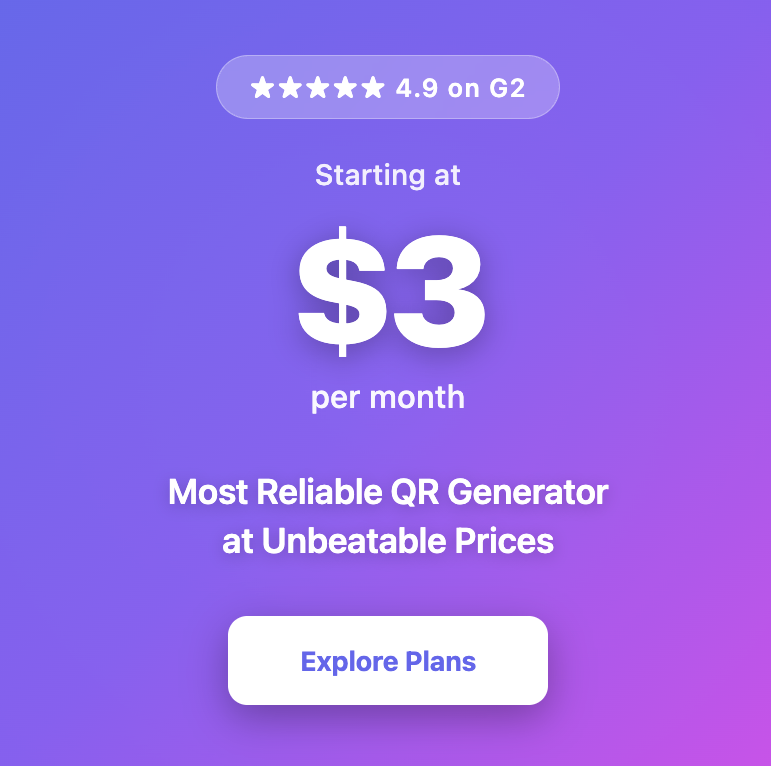How to Create QR Codes for Food Packaging

Food Packaging QR Code Generator
Create interactive QR codes for your food products
Food Packaging QR Solutions
Why use QR codes on food packaging?
- Provide allergen information and nutritional details
- Share origin and sustainability practices
- Offer cooking instructions and recipe ideas
- Build customer loyalty with exclusive content
Have you ever noticed how cramped food labels can get?
There’s barely room to breathe between ingredients, allergens, nutrition facts, and cooking instructions, let alone make the packaging look good.
That’s where QR codes for food packaging come in. Think of them as tiny digital doors that open up to everything a customer might want to know about their food without turning your packaging into a novel.
These food QR codes are transforming how brands connect with consumers. Before diving into how QR codes for food can revolutionize your packaging strategy, let’s break down what these clever little squares can do.
What is a food packaging QR code?
A food packaging QR code is a code that stores digital information about food products. Unlike traditional packaging color codes, these QR codes act as a bridge between physical packaging and digital content, allowing brands to share extensive product details.
Source: Pinterest
When scanned using a smartphone, a packaging QR code can instantly reveal everything from nutritional information and allergen warnings to preparation instructions and ingredient sourcing.
Benefits of using QR codes for food packaging
Here are the key benefits of using QR codes for food packaging:
Unlimited information sharing
Store detailed product information that wouldn’t fit on physical packaging, including nutritional facts, allergen warnings, recipes, and sourcing details. Your customers get complete transparency without cluttering your package design.
Real-time updates
Update product information, recall notices, or promotional content instantly through your QR code portal – no need to reprint packaging or issue separate communications. This flexibility saves time and printing costs while keeping consumers informed. When you create dynamic QR codes, as all you have to do is update the information in the original rather than create a new code every time.
Enhanced consumer trust
Build credibility by providing complete transparency about your ingredients, sourcing practices, and manufacturing processes using product QR codes. Consumers can trace their food from farm to table, boosting confidence in your brand.
Multilingual support
Reach diverse markets by offering product information in multiple languages through a single QR code, eliminating the need for different packaging versions and reducing production costs.
Interactive marketing opportunities
Transform packaging into a marketing channel by linking to cooking tutorials, brand stories, loyalty programs, or social media. This engagement extends beyond the point of purchase, building lasting customer relationships.
Supply chain traceability
Dynamic QR codes serve as digital tracking points throughout your supply chain. Each scan, from farm to warehouse to store, logs the product’s location and timestamp in a centralized system. When scanned, these codes reveal a product’s complete journey, making it easy to trace issues to their source or manage recalls. Since they’re dynamic, you can also update tracking information remotely without changing the physical code on the packaging.
Environmental impact reduction
Minimize packaging size by moving detailed information online, reducing material usage and environmental impact. Plus, digital updates mean less waste from outdated packaging.
Valuable consumer insights
Gather data on consumer behavior through packaging QR code scans, including which information they access most, when they engage with products, and how they use them. These insights help improve products and marketing strategies.
Use cases of food packaging QR codes
Here are practical ways to implement food packaging QR codes in your business:
Product authentication
Print QR codes directly on premium food items to help consumers verify product authenticity. This is especially valuable for high-end products like specialty oils, wines, or imported goods.
Source: Pinterest
Recipe integration
Add QR codes for food that link to recipe databases, showing customers creative ways to use your product. Perfect for ingredients, spices, or cooking supplies that can be used in multiple dishes.
Allergen information
Display comprehensive allergen details through QR code for retail food items, ensuring customers with dietary restrictions can make informed decisions. You can easily change the QR code destination to update allergen information when needed.
Digital nutrition labels
Use food packaging QR codes to share detailed nutritional information, supplement facts, and portion guidance. Create interactive calorie calculators, offer portion size visuals, and provide detailed vitamin and mineral breakdowns. For products with multiple serving suggestions, include nutritional variations for different preparation methods.
Batch tracking
Implement QR codes for inventory management, making it easier to track batches through production and distribution. This helps manage recalls efficiently if needed.
Marketing promotions
Source: Pinterest
Connect packages to seasonal promotions, cooking contests, or loyalty programs. Using the best QR code generators, you can create dynamic codes that update content without reprinting packaging.
Sustainability information
Share your product’s environmental impact through scannable codes that reveal detailed recycling guides, carbon footprint data, and sustainability certifications. Include interactive maps showing local recycling facilities and tips for eco-friendly disposal, helping environmentally conscious consumers make responsible choices while supporting your green initiatives.
Supply chain transparency
Show customers your product’s journey from source to shelf, building trust through transparency about origins and handling.
How to generate QR codes for food packaging
Here’s how to create QR codes for your food packaging using Mobiqode:
Step 1: Sign up for Mobiqode
Visit Mobiqode’s website and create a free account. You’ll have instant access to professional QR code generation tools designed for food packaging.
Step 2: Choose website URL/PDF
Select “Website URL” from the QR code types. Enter the web address where you’ll host your product information, nutrition facts, or marketing content.
Step 3: Create and customize the code
Design your QR code to match your brand. Choose custom colors, add your logo, and select a suitable pattern style. Ensure the code complements your packaging design while maintaining scannability.
Step 4: Test and download your code
Before downloading, test your QR code on different devices to ensure it scans properly. In Mobiqode though, you can get this verification as and when you design the code. It will tell you if the scannability of the code is poor or excellent. Once verified, download your code in high-resolution formats suitable for packaging print requirements.
That’s it! In four easy steps, you can create your food packaging QR code and ensure your customers get to know your product and brand easily.
Transform your food packaging with QR codes
Food packaging QR codes are revolutionizing how brands connect with consumers, share product information, and manage inventory.
Whether you’re a small artisanal food producer or a large manufacturer, implementing QR codes can significantly enhance your packaging strategy while building consumer trust.
Ready to take your food packaging to the next level?
Start your 14-day free trial with mobiQode and experience firsthand how QR codes can transform your product packaging. Create your first food QR code today!
QR codes are the bridge between the physical and digital world. We’re making it simple for everyone to create, share, and connect.
— Ankita Saraswat, Founder of mobiQode
Ready to Create Your QR Code?
Choose from our suite of specialized QR code generators
